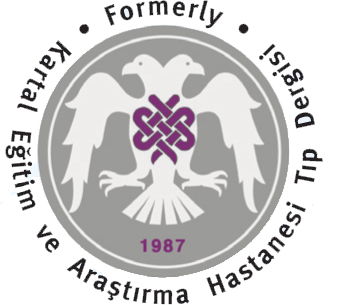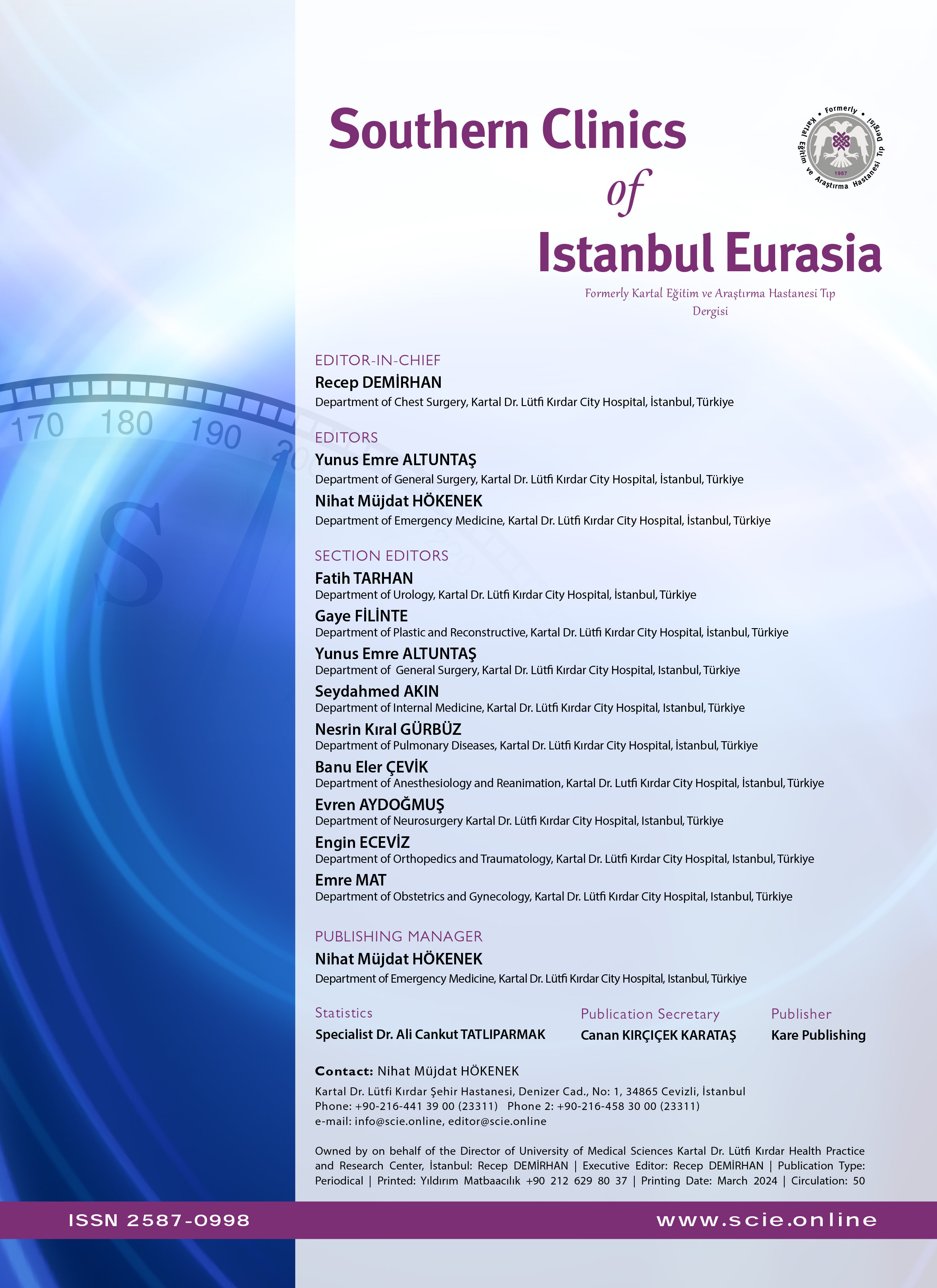Evaluation of the Factors Affecting Percutaneous Success and Complications of Nephrolithotomy
Osman Murat İpek1, Kaya Horasanlı21Department of Urology, University of Health Sciences Kartal Dr. Lütfi Kırdar Training and Research Hospital, İstanbul, Turkey2Department Of Urology, Şişli Hamidiye Etfal Training and Research Hospital, İstanbul, Turkey
INTRODUCTION: Nowadays, surgical procedures become more reliable as urinary system stone disease begins to be treated with minimally invasive methods. Percutaneous nephrolithotomy (PNL) is the first treatment option for kidney stones >2 cm. An increase in postoperative stone-free (SF) rates due to improvements in technology and experience, operation, and hospital stay is reduced. Over time, complications of PNL have been reduced and more standardized with classifications similar to the developed Clavien grading system. The aim of the present study was to comparatively investigate the factors that are considered to affect success and complications in PNL operation.
METHODS: The present study included 928 patients (1011 renal units) who underwent PNL operation between November 2004 and January 2013 in our clinic. These patients had preoperative (sex, age, body mass index (BMI), operation side, previous stone operations, hydronephrosis and grade, stone localization, stone area, and volume), operative (operation time, fluoroscopy time, number of access, and calyces of access), and postoperative (hemoglobin, hematocrit, complication, transfusion, stone removal, nephrostomy withdrawal time, length of hospital stay, and need for additional intervention). The complications that occurred during and after the operation were classified according to the modified Clavien system. Subsequently, patients were divided into two groups: patients with complications (Group 1) and those with no complications (Group 2). The groups were analyzed comparatively.
RESULTS: Overall, 628 male and 383 female (M/F: 8/5) patients were included in the study. The mean age of the patients was 41.9 years. Of the evaluated operations, 185 had minor or major complications, and 826 had no complications. Complications in PNL operation are classified according to the modified Clavien grading: 23 (2.27%) complications in grade 1, 143 (14.14%) complications in grade 2, 11 (1.08%) complications in grade 3A, 6 (0.59%) complications in grade 3B, 4 (0.39%) complications in grade 4A, and 15 (4.48%) complications in grade 4B. No complication according to grade 5 was observed. Statistically, stone size, preoperative hydronephrosis grade, time of operation and fluoroscopy, length of stay in the hospital, and SF rates were found to be effective parameters on complication development in both groups (p<0.05). Age, gender, BMI, number of access to the kidney, and postoperative complications were not found to be effective parameters in terms of complication development (p>0.05).
DISCUSSION AND CONCLUSION: PNL is an effective and reliable method for the treatment of urinary stone disease. Most of the complications are minor. Stone size, presence of preoperative hydronephrosis, long operation times, and excessive access to the kidney collecting system increase the complication rates. Another important result obtained in the present study is that the complication rates are higher in patients with high SF rates than in other patients.
Perkütan Nefrolitotomi Başarı ve Komplikasyonlarını Etkileyen Faktörlerin Değerlendirilmesi
Osman Murat İpek1, Kaya Horasanlı21Dr. Lütfi Kırdar Kartal Eğitim Ve Araştırma Hastanesi, Üroloji Kliniği, İstanbul2Şişli Hamidiye Etfal Hastanesi, Üroloji Kliniği, İstanbul
GİRİŞ ve AMAÇ: Günümüzde üriner sistem taş hastalığının minimal invaziv yöntemlerle tedavi edilmeye başlamasıyla cerrahi prosedürler güvenilir hale gelmeye başlamıştır. Perkütan nefrolitotomi (PNL) operasyonu, 2 cmden büyük böbrek taşlarında ilk tedavi seçeneği haline gelmiştir. Teknolojideki gelişmeler ve tecrübenin artmasıyla operasyon sonrası taşsızlık oranlarında artış; operasyon ve hastanede yatış sürelerinde azalma olmuştur. Zaman içinde PNL komplikasyonları azalmış ve geliştirilen Clavien derecelendirme sistem benzeri sınıflandırılmalarla daha standart hale getirilmiştir. Bu çalışmada, PNL operasyonunda başarıyı ve komplikasyonları etkilediği düşünülen faktörlerin karşılaştırmalı olarak araştırılması amaçlandı.
YÖNTEM ve GEREÇLER: Çalışmamızda Kasım 2004 ile Ocak 2013 arasında kliniğimizde PNL operasyonu uygulanmış 928 hasta (1011 renal ünite) dahil edildi. Bu hastaların ameliyat öncesi [cinsiyet, yaş, vücut kitle indeksi (VKİ), operasyon tarafı, daha önce taş nedeniyle yapılan işlemler, hidronefroz ve derecesi, taş lokalizasyonu, taş alanı ve hacmi], operatif (operasyon süresi, skopi süresi, giriş yeri sayısı, giriş yapılan kaliks) ve ameliyat sonrası (hemoglobin, hemotokrit, komplikasyon, transfüzyon yapılması, taşsızlık, nefrostomi çekilme süresi, hastanede kalış süresi, ek girişim ihtiyacı) verileri geriye dönük olarak dosya kayıtlarından incelendi. Operasyon esnasında ve operasyon sonrasında meydana gelen komplikasyonlar modifiye Clavien sistemine göre sınıflandırıldı. Daha sonra olgular, komplikasyon gelişen hastalar (Grup 1) ve gelişmeyenler (Grup 2) olarak ikiye ayrıldı. Gruplar karşılaştırmalı olarak analiz edildi.
BULGULAR: Çalışmaya alınan hastaların 628 erkek, 383 kadın (E/K: 8/5), yaş ortalaması ise 41.9 idi. Değerlendirilen operasyonların 185inde minör veya majör bir adet komplikasyon gelişirken, 826sında komplikasyon gelişmediği görüldü. PNL operasyonunda görülen komplikasyonlar modifiye Clavien derecelendirilmesine göre sınıflandırıldığında derece 1de 23 (%2.27) komplikasyon, derece 2de 143 (%14.14) komplikasyon, derece 3Ada 11 (%1.08) komplikasyon, derece 3Bde 6 (%0.59) komplikasyon, derece 4Ada 4 (%0.39) komplikasyon, derece 4Bde 15 (%1.48) komplikasyon görülürken, derece 5e uygun komplikasyon görülmedi. Her iki grup arasında yapılan karşılaştırmada taşın büyüklüğü, preoperatif hidronefroz derecesi, operasyon ve floroskopi süreleri, hastanede kalış süreleri ve taşsızlık oranlarının komplikasyon gelişimi üzerine etkili parametreler olduğu istatistiksel olarak gösterildi (p<0.05). Hastanın yaşı, cinsiyeti, VKİ, böbreğe giriş sayısı, operasyon sonrası ek girişimlerin ise komplikasyon gelişimi açısından etkili parametreler olmadığı saptandı (p>0.05).
TARTIŞMA ve SONUÇ: Perkütan nefrolitotomi, üriner sistem taş hastalığı tedavisinde etkin ve güvenilir bir yöntemdir. Meydana gelen komplikasyonların çoğu minör komplikasyonlardır. Taş büyüklüğü, ameliyat öncesi hidronefroz varlığı, uzun operasyon süreleri, böbrek toplayıcı sistemine fazla giriş yapılması komplikasyon oranlarını artırmaktadır. Bu çalışmada elde ettiğimiz başka önemli bir sonuç ise taşsızlık oranlarının yüksek olduğu hastalarda komplikasyon oranlarının da diğer hastalara göre yüksek olmasıdır.
Corresponding Author: Osman Murat İpek, Türkiye
Manuscript Language: Turkish



















